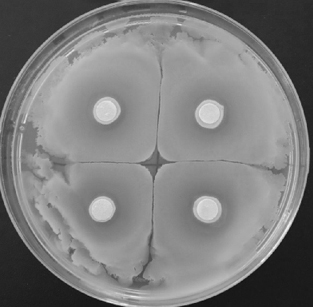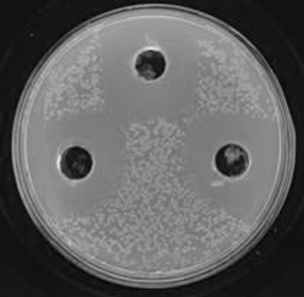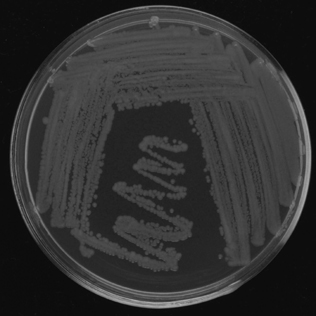Klebsiella sp. and use thereof in preventing and treating of fire blight of fruit trees
A technology for Klebsiella and fire blight, which is applied to Klebsiella and its application field in the biological control of fruit tree pear fire blight, and achieves the effects of significant antagonism, good control effect and simple fermentation process
- Summary
- Abstract
- Description
- Claims
- Application Information
AI Technical Summary
Problems solved by technology
Method used
Image
Examples
Embodiment 1
[0022] Example 1 Isolation, Purification and Screening of Endophytic Antagonistic Bacteria TN50 Strain in Fragrant Pear
[0023] (1) Isolation of endophytic bacteria in fragrant pear trees: Rinse the collected branches, flowers, leaves and fruits of healthy fragrant pear trees under running water for 1-2 hours, then rinse them with sterile water, weigh the petals, branches (cut into small pieces of 0.5~1 cm) and leaves and fruits (cut into 4mm 2 1 g each, soaked in 75% alcohol for 1 min, then soaked in 1% sodium hypochlorite for 2-5 min, and rinsed with sterile water for 3-5 times. Take 0.1 mL of the last sterile water rinse solution and spread it on the NA medium, place it in a 28°C incubator and incubate for 2-3 days, observe whether there are colonies growing, and check whether the surface of the sample is completely sterilized. Take a thoroughly sterilized sample on the surface and put it into a sterilized mortar, add 10 mL of PBS buffer solution to each 1 g sample to gri...
Embodiment 2
[0035] Identification of embodiment 2 TN50 bacterial strain
[0036] Strain TN50 was streak-inoculated on NA medium, cultured at 28°C for 24 h, and its colony morphology was observed and described. At the same time, Gram staining was carried out to observe the size, shape, presence or absence, shape and location of spores of the tested strains. The physiology and biochemistry mainly refer to the "Common Bacteria System Identification Manual".
[0037] (1) Colony characteristics and morphological characteristics of bacteria
[0038] TN50 colony characteristics such as ( image 3 ), the colonies on the NA medium are round, viscous and shiny, with neat edges, opaque, light yellow, and the morphological characteristics of the bacteria are as ( Figure 4 ) shows rod-shaped bacteria, G - , no spores, no flagella.
[0039] (2) Identification of physiological and biochemical properties
[0040] Refer to the method in the "Common Bacteria System Identification Manual" for determin...
Embodiment 3
[0046] Example 3 Determination of the control effect of Klebsiella TN50 strain on amygdalus blight in isolated inflorescences of fragrant pears
[0047] Flower branches were collected at the early flowering stage of the fragrant pear orchard, and inserted into 0.05% NaCl solution for antisepsis and moisturizing. Use a hand-held pressure sprayer to inoculate pear inflorescences with TN50 fermentation broth, spray about 80 µL of the bacteria spray solution on each flower, inoculate 50 inflorescences, and repeat 3 times; at the same time, spray agricultural streptomycin (produced by North China Pharmaceutical Factory, active ingredient 72 %) 4000 times liquid control, and sterile water as a blank control, after 24 hours of culture in an artificial climate box at 25°C and 70% air humidity, the pathogenic bacteria liquid was sprayed, about 80 µL per flower. Place the inoculated inflorescences in an artificial climate box at 25°C and 70% air humidity for cultivation. After 3 days, 5...
PUM
| Property | Measurement | Unit |
|---|---|---|
| Diameter | aaaaa | aaaaa |
Abstract
Description
Claims
Application Information
 Login to View More
Login to View More - R&D
- Intellectual Property
- Life Sciences
- Materials
- Tech Scout
- Unparalleled Data Quality
- Higher Quality Content
- 60% Fewer Hallucinations
Browse by: Latest US Patents, China's latest patents, Technical Efficacy Thesaurus, Application Domain, Technology Topic, Popular Technical Reports.
© 2025 PatSnap. All rights reserved.Legal|Privacy policy|Modern Slavery Act Transparency Statement|Sitemap|About US| Contact US: help@patsnap.com



